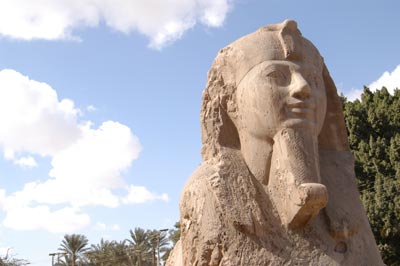










more photos
site details
0730 -- 1600 summer
0730 -- 1700 winter
£E14 entry fee
£E7 entry student
£E10 camera
£E100 video camera
relevant links
history
New kingdom
18th Dynasty
Amenemhet III
Hatshepsut
Thutmose III
Alabaster Sphinx
Everyone has seen the face of the giant Great Sphinx at Giza, but most people don't see the hundreds of sphinxes that remain in the temples and ruins in Egypt. The Great Sphinx is certainly not alone.

the imposing and chubby-faced alabaster sphinx
Some have ram heads, others human heads and lion bodies, some have lion heads. There are a half-dozen in the Cairo Museum, and a line of identical ram-headed sphinxes line the causeway between the Temple of Luxor and the Temple at Karnak -- some thirty or so of them sit in the great courtyard awaiting the reconstruction of the road.
This particular sphinx is from the 18th dynasty and weighs in at more tnan 80 tons. Authorities differ on what they think it is made of -- most say calcite, not actually alabaster (although I'm hard put to know the difference!). It is the largest calcite/alabaster statue known. It is 26 feet long and carved of a single piece of stone, base and all. It sits on a pedestal that has been raised up out of the sands, so that it seems to be rising out of the earth.

possibly the face of amenhotep III
The face is probably that of Amenhotep III, one of the builders of the Luxor temple.